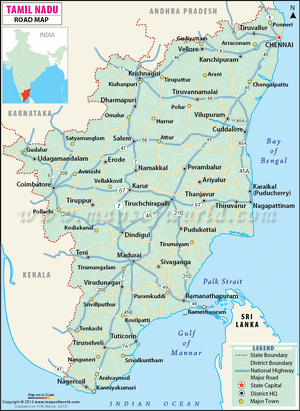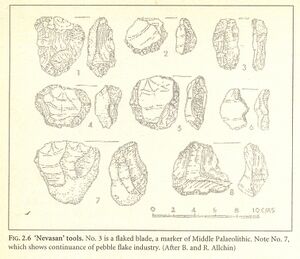Attirampakkam
| Author:Laxman Burdak, IFS (R) |

Attirampakkam (अतिरमपक्कम) is a village located 60 kilometers away from Chennai, Tamil Nadu, India. The oldest known stone tools in India were discovered near the village,[1][2] which became the type site for the Madrasian culture.[3] [4]
Variants
- Athirampakkam (Tamil: அத்திரம்பாக்கம்)
Location
Attirampakkam is situated 60 km northwest from the urban landscape of Chennai, near a meandering tributary of Kortallaiyar river. Attirampakkam could be the oldest pre-historic site in South Asia.[5]
Prehistory

Irfan Habib[6] writes that...[p.26] Many sites in south India including Hunsgi valley in Karnataka, and Attirampakkam, near Chennai, have turned up “Early Acheulean tools” (of the so -
[p.27]: called 'Madras industry'), that is, hand axes, etc., made mainly from the cores (see Fig. 2.5).

The U-Th method has yielded dates going back to beyond 350,000 years for sites in Karnataka. Lower Palaeolithic artefacts at Didwana in Rajasthan have been dated by the same means to 390,000 years ago, and at Nevasa in Ahmadnagar district of Maharashtra to 350,000 years ago.
During this process of his diffusion there was a tendency over time for the original Homo erectus to evolve into sub-species that were less robust but more dexterous, and so could make smaller tools out of flakes or the 'Late Acheulean tools'. Remains of such tools have been found in the Narmada valley, where these appear in association with the 'Narmada skull' discovered at Hathnora. This skull, belonging to an evolved Homo erectus could date back to a time earlier than 130,000 years ago. At the famous cave of Bhimbetka in the same area, successive periods of occupation begin with the lowest floors containing Late Acheulean tools.
As Homo erectus evolved, he also improved his tools, giving them new shapes and adjusting the technique to locally available materials. Such changes occurred very slowly, over tens of thousands of years, but these ultimately led to the rise of regional 'cultures'. The term 'culture' is used when archaeologists find at a layer in one or more sites a similar assemblage of tools, ornaments and other products of human labour, which they call 'artefacts', as well as indications of similar customs and beliefs, such as systems of disposing of the dead, and ritual symbols. Regarding Homo erectus, there is little known of custom or belief, and the forms of his stone tools alone supply us with clues to his varied cultures. As the millennia passed, the tendency was for the production of smaller and thinner tools; and the apparently independent appearances of the flake blade in many parts of the world were a natural result of such a tendency. The flake blade is supposed to mark the Middle Palaeolithic stage in India. Such stone blades are found in the 'Nevasa culture' (named after the site of Nevasa already mentioned), which seems to have extended over the southern peninsula and central India (see Fig. 2.6).

At Didwana, the Middle Paeolithic is dated by the TL method to about 150.000 years, ago, but in Gujarat a date as late as 56,800 years ago has been obtained by the U-Th method. In Sri Lanka's southern wet zone, a range of 200,000 to 40,000 years ago has been suggested for it. So the culture may have lasted for a hundred thousand years, if not more. This culture is held to be in direct continuity with the Lower Palaeolithic; and, therefore, its authors were probably the direct descendants of the late Homo erectus, though no skeletal remains have yet been found at any of the sites.
History
Discovery and dating of artifacts
A large number of stone tools were recovered from Attirampakkam over 20 years by archaeologists from the Sharma Centre for Heritage Education in India and other Indian institutions.Due to the paucity of any hominine fossils or bones recovered yet from the site or from South Asia as a whole, it is currently not possible to conclude which hominin species had created these tools. [7]
By performing a luminescence dating method called post-Infrared-Stimulated Luminescence (pIR-IRSL) on about 7,200 artifacts found at Attirampakkam, researchers have made a chronology of Attirampakkam stone tool technology with a span of about 200,000 years.[8] Latest studies indicate that the Levallois technology used at Attirampakkam emerged at about 385,000 (± 64,000) years ago, at a time period when processes signifying the end of the Acheulian culture occurred and a Middle Palaeolithic culture had emerged.[9][10]
External links
References
- ↑ khilesh, Kumar; Pappu, Shanti; Rajapara, Haresh M.; Gunnell, Yanni; Shukla, Anil D.; Singhvi, Ashok K. (2018-01-31). "Early Middle Palaeolithic culture in India around 385–172 ka reframes Out of Africa models". Nature. 554 (7690): 97–101. doi:10.1038/nature25444. ISSN 1476-4687. PMID 29388951
- ↑ "Tools found in India suggest humans left Africa earlier than we thought". Quartz.
- ↑ http://www.antiquity.ac.uk/projgall/pappu297/
- ↑ Ancient Stone Tools Found in Tamil Nadu Push Back ‘Out of Africa’ Exodus Date
- ↑ newindianexpress.com
- ↑ People’s History of India 1, Prehistory, by Irfan Habib, Aligarh Historians Society, Published by Tulika Books, Second Edition, 2002, ISBN: 81-85229-68-6,p.26-27
- ↑ Becker, Rachel (2018-01-31). "Discovery of ancient stone tools rewrites the history of technology in India". The Verge.
- ↑ Tarlach, Gemma (2018-01-31). "Stone Tools From India: Another Blow To Human Evolution Model?". Discover Magazine.
- ↑ Akhilesh, Kumar; Pappu, Shanti; Rajapara, Haresh M.; Gunnell, Yanni; Shukla, Anil D.; Singhvi, Ashok K. (2018-01-31). "Early Middle Palaeolithic culture in India around 385–172 ka reframes Out of Africa models". Nature. 554 (7690): 97–101. doi:10.1038/nature25444. ISSN 1476-4687. PMID 29388951.
- ↑ Tarlach, Gemma (2018-01-31). "Stone Tools From India: Another Blow To Human Evolution Model?". Discover Magazine.

